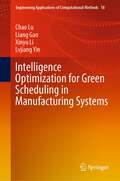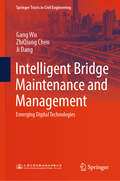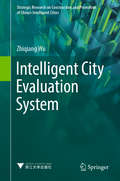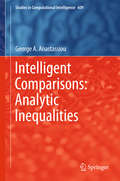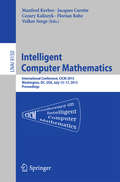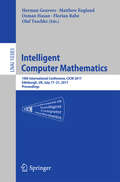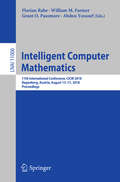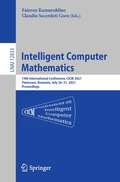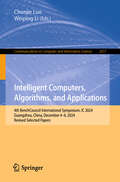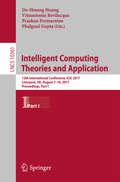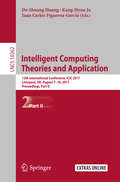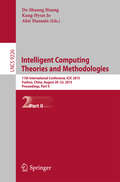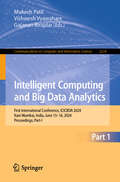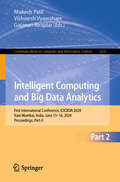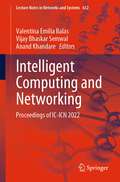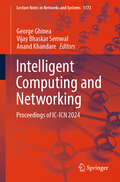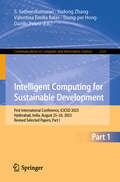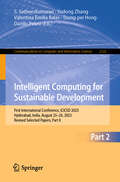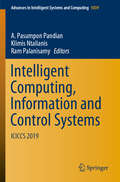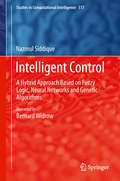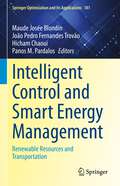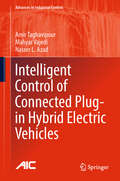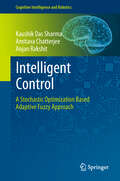- Table View
- List View
Intelligence Optimization for Green Scheduling in Manufacturing Systems (Engineering Applications of Computational Methods #18)
by Liang Gao Xinyu Li Chao Lu Lvjiang YinThis book investigates in detail production scheduling technology in different kinds of shop environment to achieve sustainability manufacturing. Studies on shop scheduling have attracted engineers and scientists from various disciplines, such as electrical, mechanical, automation, computer, and industrial engineering. Pursuing a holistic approach, the book establishes a fundamental framework for this topic, while emphasizing the importance of intelligent optimization and the significant influence of production scheduling in the manufacturing systems. The book is intended for undergraduate and graduate students who are interested in intelligent optimization technology, shop scheduling, and green manufacturing systems or other scheduling applications.
Intelligent Bridge Maintenance and Management: Emerging Digital Technologies (Springer Tracts in Civil Engineering)
by Gang Wu Ji Dang ZhiQiang ChenThis book provides a timely introduction to the methodology of Intelligent Bridge Maintenance and Management (IBM&M) and a comprehensive synthesis of emerging digital technologies for realizing IBM&M. The authors, who carry research, teaching, and consulting experience in the USA, Japan, and China, present the background, principles, methods, and application examples of essential IBM&M solutions in eight dedicated chapters. The digital technologies covered in this book include: • Artificial intelligence, big data, machine learning, computer vision. • Data fusion, 3D building information, digital twin modeling, virtual and augmented reality. • Internet of things sensors, robotics including unmanned vehicles. The book targets the audience in the broader Bridge Engineering community, including academic researchers, students, bridge owners, and technology providers.
Intelligent City Evaluation System (Strategic Research on Construction and Promotion of China's Intelligent Cities)
by Zhiqiang WuThis book assesses various intelligent-city evaluation systems around the globe, and subsequently combines that assessment with local-government and enterprise practices to create an evaluation index system for quantifying the Intelligent City concept. In addition, the book provides the results of the CityIQ indicator ranking of intelligent cities in China and worldwide, a system that focuses on three of the most crucial aspects of urban development: the development environment, future trends, and construction and operation. After data sorting, calculation and dimensionless treatment, a score system ranging from 0 to 100 is created for ranking and analyzing cities. Providing unique strategies for promoting an intelligent city evaluation system, the book offers a valuable reference guide for intelligent-city decision-makers, as well as leaders in public urban economy, social welfare and environmental authorities.
Intelligent Comparisons: Analytic Inequalities
by George A. AnastassiouThis monograph presents recent and original work of the author on inequalities in real, functional and fractional analysis. The chapters are self-contained and can be read independently, they include an extensive list of references per chapter. The book's results are expected to find applications in many areas of applied and pure mathematics, especially in ordinary and partial differential equations and fractional differential equations. As such this monograph is suitable for researchers, graduate students, and seminars of the above subjects, as well as Science and Engineering University libraries.
Intelligent Computer Mathematics
by Manfred Kerber Jacques Carette Cezary Kaliszyk Florian Rabe Volker SorgeThis book constitutes the refereed proceedings of the International Conference on Intelligent Computer Mathematics, CICM 2015, held in Washington, DC, USA, in July 2015. The 16 full papers and 9 short papers presented together with two invited talks plus one abstract were carefully reviewed and selected from a total of 43 submissions. The papers are organized in topical sections following the tracks of the conference: Invited Talks; Calculemus; Digital Mathematics Libraries; Mathematical Knowledge Management; Projects and Surveys; Systems and Data.
Intelligent Computer Mathematics
by Herman Geuvers Florian Rabe Matthew England Osman Hasan Olaf TeschkeThis book constitutes the joint refereed proceedings of three international events, namely the 18th Symposium on the Integration of Symbolic Computation and Mechanized Reasoning, Calculemus 2011, the 10th International Conference on Mathematical Knowledge Management, MKM 2011, and a new track on Systems and Projects descriptions that span both the Calculemus and MKM topics, all held in Bertinoro, Italy, in July 2011. All 51 submissions passed through a rigorous review process. A total of 15 papers were submitted to Calculemus, of which 9 were accepted. Systems and Projects track 2011 there have been 12 papers selected out of 14 submissions while MKM 2011 received 22 submissions, of which 9 were accepted for presentation and publication. The events focused on the use of AI techniques within symbolic computation and the application of symbolic computation to AI problem solving; the combination of computer algebra systems and automated deduction systems; and mathematical knowledge management, respectively.
Intelligent Computer Mathematics: 11th International Conference, CICM 2018, Hagenberg, Austria, August 13-17, 2018, Proceedings (Lecture Notes in Computer Science #11006)
by Florian Rabe William M. Farmer Grant O. Passmore Abdou YoussefThis book constitutes the refereed proceedings of the 11th International Conference on Intelligent Computer Mathematics, CICM 2018, held in Hagenberg, Austria, in August 2018. The 23 full papers presented were carefully reviewed and selected from a total of 36 submissions. The papers focos on the Calculemus, Digital Mathematics Libraries, and Mathematical Knowledge Management tracks which also correspond to the subject areas of the predecessor meetings. Orthogonally, the Systems and Projects track called for descriptions of digital resources, such as data and systems, and of projects, whether old, current, or new, and survey papers covering any topics of relevance to the CICM community.
Intelligent Computer Mathematics: 14th International Conference, CICM 2021, Timisoara, Romania, July 26–31, 2021, Proceedings (Lecture Notes in Computer Science #12833)
by Fairouz Kamareddine Claudio Sacerdoti CoenThis book constitutes the refereed proceedings of the 14th International Conference on Intelligent Computer Mathematics, CICM 2021, held in Timisoara, Romania, in July 2021*.The 12 full papers, 7 system descriptions, 1 system entry, and 3 abstracts of invited papers presented were carefully reviewed and selected from a total of 38 submissions. The papers focus on advances in formalization, automatic theorem proving and learning, search and classification, teaching and geometric reasoning, and logic and systems, among other topics.* The conference was held virtually due to the COVID-19 pandemic.
Intelligent Computer Mathematics: 16th International Conference, CICM 2023, Cambridge, UK, , September 5–8, 2023 Proceedings (Lecture Notes in Computer Science #14101)
by Manfred Kerber Catherine DuboisThis book constitutes the refereed proceedings of the 16th International Conference on Intelligent Computer Mathematics, CICM 2023, held in Cambridge, UK, in September 2023.The 14 full papers, 2 project/survey papers, 6 short papers, and 1 tool paper presented were carefully reviewed and selected from a total of 37 submissions. The papers focus on advances in formalization, automatic theorem proving and learning, search and classification, teaching and geometric reasoning, and logic and systems, among other topics.
Intelligent Computers, Algorithms, and Applications: 4th BenchCouncil International Symposium, IC 2024, Guangzhou, China, December 4–6, 2024, Revised Selected Papers (Communications in Computer and Information Science #2517)
by Weiping Li Chunjie LuoThis book constitutes the proceedings of the 4th BenchCouncil International Symposium on Intelligent Computers, Algorithms, and Applications, IC 2024, held in Guangzhou, China, during December 4–6, 2024. The 16 full papers included in this book were carefully reviewed and selected from 31 submissions. They were organized in topical sections as follows: Algorithms; Education; Evaluation; System.
Intelligent Computing Theories and Application
by Phalguni Gupta Prashan Premaratne De-Shuang Huang Vitoantonio BevilacquaThe International Conference on Intelligent Computing (ICIC) was formed to provide an annual forum dedicated to the emerging and challenging topics in artificial intel- gence, machine learning, pattern recognition, image processing, bioinformatics, and computational biology. It aims to bring together researchers and practitioners from both academia and industry to share ideas, problems, and solutions related to the m- tifaceted aspects of intelligent computing. ICIC 2010, held in Changsha, China, August 18-21, 2010, constituted the 6th - ternational Conference on Intelligent Computing. It built upon the success of ICIC 2009, ICIC 2008, ICIC 2007, ICIC 2006, and ICIC 2005, that were held in Ulsan, Korea, Shanghai, Qingdao, Kunming and Hefei, China, respectively. This year, the conference concentrated mainly on the theories and methodologies as well as the emerging applications of intelligent computing. Its aim was to unify the picture of contemporary intelligent computing techniques as an integral concept that highlights the trends in advanced computational intelligence and bridges theoretical research with applications. Therefore, the theme for this conference was "Advanced Intelligent Computing Technology and Applications. " Papers focusing on this theme were solicited, addressing theories, methodologies, and applications in science and technology.
Intelligent Computing Theories and Application
by De-Shuang Huang Kang-Hyun Jo Juan Carlos Figueroa-GarcíaThe International Conference on Intelligent Computing (ICIC) was formed to provide an annual forum dedicated to the emerging and challenging topics in artificial intel- gence, machine learning, pattern recognition, image processing, bioinformatics, and computational biology. It aims to bring together researchers and practitioners from both academia and industry to share ideas, problems, and solutions related to the m- tifaceted aspects of intelligent computing. ICIC 2010, held in Changsha, China, August 18-21, 2010, constituted the 6th - ternational Conference on Intelligent Computing. It built upon the success of ICIC 2009, ICIC 2008, ICIC 2007, ICIC 2006, and ICIC 2005, that were held in Ulsan, Korea, Shanghai, Qingdao, Kunming and Hefei, China, respectively. This year, the conference concentrated mainly on the theories and methodologies as well as the emerging applications of intelligent computing. Its aim was to unify the picture of contemporary intelligent computing techniques as an integral concept that highlights the trends in advanced computational intelligence and bridges theoretical research with applications. Therefore, the theme for this conference was "Advanced Intelligent Computing Technology and Applications. " Papers focusing on this theme were solicited, addressing theories, methodologies, and applications in science and technology.
Intelligent Computing Theories and Methodologies
by De-Shuang Huang Kang-Hyun Jo Abir HussainThis two-volume set LNCS 9225 and LNCS 9226 constitutes - in conjunction with the volume LNAI 9227 - the refereed proceedings of the 11th International Conference on Intelligent Computing, ICIC 2015, held in Fuzhou, China, in August 2015. The total of 191 full and 42 short papers presented in the three ICIC 2015 volumes was carefully reviewed and selected from 671 submissions. The papers are organized in topical sections such as evolutionary computation and learning; compressed sensing, sparse coding and social computing; neural networks, nature inspired computing and optimization; pattern recognition and signal processing; image processing; biomedical informatics theory and methods; differential evolution, particle swarm optimization and niche technology; intelligent computing and knowledge discovery and data mining; soft computing and machine learning; computational biology, protein structure and function prediction; genetic algorithms; artificial bee colony algorithms; swarm intelligence and optimization; social computing; information security; virtual reality and human-computer interaction; healthcare informatics theory and methods; unsupervised learning; collective intelligence; intelligent computing in robotics; intelligent computing in communication networks; intelligent control and automation; intelligent data analysis and prediction; gene expression array analysis; gene regulation modeling and analysis; protein-protein interaction prediction; biology inspired computing and optimization; analysis and visualization of large biological data sets; motif detection; biomarker discovery; modeling; simulation; and optimization of biological systems; biomedical data modeling and mining; intelligent computing in biomedical signal/image analysis; intelligent computing in brain imaging; neuroinformatics; cheminformatics; intelligent computing in computational biology; computational genomics; special session on biomedical data integration and mining in the era of big data; special session on big data analytics; special session on artificial intelligence for ambient assisted living; and special session on swarm intelligence with discrete dynamics.
Intelligent Computing and Big Data Analytics: First International Conference, ICICBDA 2024, Navi Mumbai, India, June 15–16, 2024, Proceedings, Part-I (Communications in Computer and Information Science #2234)
by Vishwesh Vyawahare Mukesh Patil Gajanan BirajdarThis book constitutes the refereed proceedings of the First International Conference on Intelligent Computing and Big Data Analytics, ICICBDA 2024, held in Navi Mumbai, India, during June 15–16, 2024. The 48 full papers presented were carefully reviewed and selected from 275 submissions. The accepted submissions report original and novel results in various fields like Intelligent Security systems, Big Data Analytics, AI and ML applications, intelligent systems, Deep Learning, Blockchain, and many more.
Intelligent Computing and Big Data Analytics: First International Conference, ICICBDA 2024, Navi Mumbai, India, June 15–16, 2024, Proceedings, Part-II (Communications in Computer and Information Science #2235)
by Vishwesh Vyawahare Mukesh Patil Gajanan BirajdarThis book constitutes the refereed proceedings of the First International Conference on Intelligent Computing and Big Data Analytics, ICICBDA 2024, held in Navi Mumbai, India, during June 15–16, 2024. The 48 full papers presented were carefully reviewed and selected from 275 submissions. The accepted submissions report original and novel results in various fields like Intelligent Security systems, Big Data Analytics, AI and ML applications, intelligent systems, Deep Learning, Blockchain, and many more.
Intelligent Computing and Networking: Proceedings of IC-ICN 2022 (Lecture Notes in Networks and Systems #632)
by Valentina Emilia Balas Vijay Bhaskar Semwal Anand KhandareThis book gathers high-quality peer-reviewed research papers presented at the International Conference on Intelligent Computing and Networking (IC-ICN 2022), organized by the Computer Department, Thakur College of Engineering and Technology, in Mumbai, Maharashtra, India, on February 25–26, 2022. The book includes innovative and novel papers in the areas of intelligent computing, artificial intelligence, machine learning, deep learning, fuzzy logic, natural language processing, human–machine interaction, big data mining, data science and mining, applications of intelligent systems in healthcare, finance, agriculture and manufacturing, high-performance computing, computer networking, sensor and wireless networks, Internet of Things (IoT), software-defined networks, cryptography, mobile computing, digital forensics and blockchain technology.
Intelligent Computing and Networking: Proceedings of IC-ICN 2024 (Lecture Notes in Networks and Systems #1172)
by George Ghinea Vijay Bhaskar Semwal Anand KhandareThis book gathers high-quality peer-reviewed research papers presented at the International Conference on Intelligent Computing and Networking (IC-ICN 2024), organized by the Computer Department, Thakur College of Engineering and Technology, in Mumbai, Maharashtra, India, on February 23–24, 2024. The book includes innovative and novel papers in the areas of intelligent computing, artificial intelligence, machine learning, deep learning, fuzzy logic, natural language processing, human–machine interaction, big data mining, data science and mining, applications of intelligent systems in healthcare, finance, agriculture and manufacturing, high-performance computing, computer networking, sensor and wireless networks, Internet of Things (IoT), software-defined networks, cryptography, mobile computing, digital forensics, and blockchain technology.
Intelligent Computing for Sustainable Development: First International Conference, ICICSD 2023, Hyderabad, India, August 25–26, 2023, Revised Selected Papers, Part I (Communications in Computer and Information Science #2121)
by Tzung-Pei Hong Valentina Emilia Balas Danilo Pelusi Yudong Zhang S. SatheeskumaranThe two-volume proceedings set CCIS 2121 and 2122 constitutes the refereed proceedings of the First International Conference on Intelligent Computing for Sustainable Development, ICICSD 2023, which took place in Hyderabad, India, during August 25–26, 2023. The 46 papers included in these proceedings were carefully reviewed and selected from 138 submissions. They focus on digital healthcare, renewable energy, smart cities, digital farming, and autonomous systems.
Intelligent Computing for Sustainable Development: First International Conference, ICICSD 2023, Hyderabad, India, August 25–26, 2023, Revised Selected Papers, Part II (Communications in Computer and Information Science #2122)
by Tzung-Pei Hong Valentina Emilia Balas Danilo Pelusi Yudong Zhang S. SatheeskumaranThe two-volume proceedings set CCIS 2121 and 2122 constitutes the refereed proceedings of the First International Conference on Intelligent Computing for Sustainable Development, ICICSD 2023, which took place in Hyderabad, India, during August 25–26, 2023. The 46 papers included in these proceedings were carefully reviewed and selected from 138 submissions. They focus on digital healthcare, renewable energy, smart cities, digital farming, and autonomous systems.
Intelligent Computing in Optimal Design (Solid Mechanics and Its Applications #261)
by Tadeusz Burczyński Witold Beluch Adam Długosz Arkadiusz Poteralski Mirosław Szczepanik Waclaw KuśThe book is devoted to intelligent design of structures as a novel kind of designing based on computational intelligence. The proposed methodology based on computational intelligence has some heuristic and learning attributes typical for natural intelligence. Computer models of the structures are built on the base of the finite element method (FEM), the boundary element method (BEM) or coupling of FEM and BEM. The short description of possible discrete models of structures using these methods is included in the Chapter 2. Various kinds of intelligent approaches using sequential, parallel, distributed, fuzzy and hybrid evolutionary, immune and particle swarm algorithms and neural computing are presented in Chapter 3. Different kinds of optimization such as shape, topology, size and material optimization for structures under static and dynamical mechanical and thermo-mechanical loadings, structures with cracks and composite structures are considered in Chapter 4. Multi-objective optimization for coupled problems is also taken into account. Several numerical examples illustrating these kinds of optimization are presented for 2-D (plane-stress or plane-strain, plates, shells) as well as 3-D structures. Chapter 5 is devoted to special problems related to solving inverse problems in which boundary conditions, defects such as voids or cracks and material characteristics, are unknown. Closing comments summarizing the book are presented in Chapter 6.
Intelligent Computing, Information and Control Systems: ICICCS 2019 (Advances in Intelligent Systems and Computing #1039)
by Klimis Ntalianis A. Pasumpon Pandian Ram PalanisamyFrom past decades, Computational intelligence embraces a number of nature-inspired computational techniques which mainly encompasses fuzzy sets, genetic algorithms, artificial neural networks and hybrid neuro-fuzzy systems to address the computational complexities such as uncertainties, vagueness and stochastic nature of various computational problems practically. At the same time, Intelligent Control systems are emerging as an innovative methodology which is inspired by various computational intelligence process to promote a control over the systems without the use of any mathematical models. To address the effective use of intelligent control in Computational intelligence systems, International Conference on Intelligent Computing, Information and Control Systems (ICICCS 2019) is initiated to encompass the various research works that helps to develop and advance the next-generation intelligent computing and control systems. This book integrates the computational intelligence and intelligent control systems to provide a powerful methodology for a wide range of data analytics issues in industries and societal applications. The recent research advances in computational intelligence and control systems are addressed, which provide very promising results in various industry, business and societal studies. This book also presents the new algorithms and methodologies for promoting advances in common intelligent computing and control methodologies including evolutionary computation, artificial life, virtual infrastructures, fuzzy logic, artificial immune systems, neural networks and various neuro-hybrid methodologies. This book will be pragmatic for researchers, academicians and students dealing with mathematically intransigent problems. It is intended for both academicians and researchers in the field of Intelligent Computing, Information and Control Systems, along with the distinctive readers in the fields of computational and artificial intelligence to gain more knowledge on Intelligent computing and control systems and their real-world applications.
Intelligent Control
by Nazmul SiddiqueIntelligent Control considers non-traditional modelling and control approaches to nonlinear systems. Fuzzy logic, neural networks and evolutionary computing techniques are the main tools used. The book presents a modular switching fuzzy logic controller where a PD-type fuzzy controller is executed first followed by a PI-type fuzzy controller thus improving the performance of the controller compared with a PID-type fuzzy controller. The advantage of the switching-type fuzzy controller is that it uses one rule-base thus minimises the rule-base during execution. A single rule-base is developed by merging the membership functions for change of error of the PD-type controller and sum of error of the PI-type controller. Membership functions are then optimized using evolutionary algorithms. Since the two fuzzy controllers were executed in series, necessary further tuning of the differential and integral scaling factors of the controller is then performed. Neural-network-based tuning for the scaling parameters of the fuzzy controller is then described and finally an evolutionary algorithm is applied to the neurally-tuned-fuzzy controller in which the sigmoidal function shape of the neural network is determined. The important issue of stability is addressed and the text demonstrates empirically that the developed controller was stable within the operating range. The text concludes with ideas for future research to show the reader the potential for further study in this area. Intelligent Control will be of interest to researchers from engineering and computer science backgrounds working in the intelligent and adaptive control.
Intelligent Control and Smart Energy Management: Renewable Resources and Transportation (Springer Optimization and Its Applications #181)
by Panos M. Pardalos Maude Josée Blondin João Pedro Fernandes Trovão Hicham ChaouiThis volume aims to provide a state-of-the-art and the latest advancements in the field of intelligent control and smart energy management. Techniques, combined with technological advances, have enabled the deployment of new operating systems in many engineering applications, especially in the domain of transport and renewable resources. The control and energy management of transportation and renewable resources are shifting towards autonomous reasoning, learning, planning and operating. As a result, these techniques, also referred to as autonomous control and energy management, will become practically ubiquitous soon. The discussions include methods, based on neural control (and others) as well as distributed and intelligent optimization. While the theoretical concepts are detailed and explained, the techniques presented are tailored to transport and renewable resources applications, such as smart grids and automated vehicles. The reader will grasp the most important theoretical concepts as well as to fathom the challenges and needs related to timely practical applications. Additional content includes research perspectives and future direction as well as insight into the devising of techniques that will meet tomorrow’s scientific needs. This contributed volume is for researchers, graduate students, engineers and practitioners in the domains of control, energy, and transportation.
Intelligent Control of Connected Plug-in Hybrid Electric Vehicles (Advances in Industrial Control)
by Amir Taghavipour Mahyar Vajedi Nasser L. AzadIntelligent Control of Connected Plug-in Hybrid Electric Vehicles presents the development of real-time intelligent control systems for plug-in hybrid electric vehicles, which involves control-oriented modelling, controller design, and performance evaluation. The controllers outlined in the book take advantage of advances in vehicle communications technologies, such as global positioning systems, intelligent transportation systems, geographic information systems, and other on-board sensors, in order to provide look-ahead trip data. The book contains simple and efficient models and fast optimization algorithms for the devised controllers to address the challenge of real-time implementation in the design of complex control systems. Using the look-ahead trip information, the authors of the book propose intelligent optimal model-based control systems to minimize the total energy cost, for both grid-derived electricity and fuel. The multilayer intelligent control system proposed consists of trip planning, an ecological cruise controller, and a route-based energy management system. An algorithm that is designed to take advantage of previewed trip information to optimize battery depletion profiles is presented in the book. Different control strategies are compared and ways in which connecting vehicles via vehicle-to-vehicle communication can improve system performance are detailed. Intelligent Control of Connected Plug-in Hybrid Electric Vehicles is a useful source of information for postgraduate students and researchers in academic institutions participating in automotive research activities. Engineers and designers working in research and development for automotive companies will also find this book of interest.Advances in Industrial Control reports and encourages the transfer of technology in control engineering. The rapid development of control technology has an impact on all areas of the control discipline. The series offers an opportunity for researchers to present an extended exposition of new work in all aspects of industrial control.
Intelligent Control: A Stochastic Optimization Based Adaptive Fuzzy Approach (Cognitive Intelligence and Robotics)
by Amitava Chatterjee Kaushik Das Sharma Anjan RakshitThis book discusses systematic designs of stable adaptive fuzzy logic controllers employing hybridizations of Lyapunov strategy-based approaches/H∞ theory-based approaches and contemporary stochastic optimization techniques. The text demonstrates how candidate stochastic optimization techniques like Particle swarm optimization (PSO), harmony search (HS) algorithms, covariance matrix adaptation (CMA) etc. can be utilized in conjunction with the Lyapunov theory/H∞ theory to develop such hybrid control strategies. The goal of developing a series of such hybridization processes is to combine the strengths of both Lyapunov theory/H∞ theory-based local search methods and stochastic optimization-based global search methods, so as to attain superior control algorithms that can simultaneously achieve desired asymptotic performance and provide improved transient responses. The book also demonstrates how these intelligent adaptive control algorithms can be effectively utilized in real-life applications such as in temperature control for air heater systems with transportation delay, vision-based navigation of mobile robots, intelligent control of robot manipulators etc.
